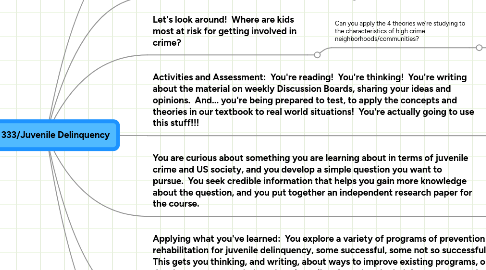SOC 333/Juvenile Delinquency
par William M. Franks


1. Sociology 333/Juvenile Delinquency
1.1. History Lesson! Where did our Western concepts of "childhood" and "juvenile delinquency" come from?
2. 4 major theoretical paradigms under which most research on juvenile delinquency is done.
2.1. Can you relate to these theories? Can you remember how tough it can be to be a kid?
2.1.1. Post clearly written, thoughtful and complete summaries of what you are reading and thinking on our weekly Discussion Boards!
3. Let's look around! Where are kids most at risk for getting involved in crime?
3.1. Can you apply the 4 theories we're studying to the characteristics of high crime neighborhoods/communities?
3.1.1. What about the 4 sociodemographic characteristics commonly thought to have some correlation with delinquent behavior?
4. Activities and Assessment: You're reading! You're thinking! You're writing about the material on weekly Discussion Boards, sharing your ideas and opinions. And... you're being prepared to test, to apply the concepts and theories in our textbook to real world situations! You're actually going to use this stuff!!!
4.1. The Discussion Boards are great practice for essay/discussion testing situations. You receive Study Guides for all tests in plenty of time to ask questions, review, etc. You have a generous 5-day testing window in which you choose a time and place free of distractions and interruptions to do your best.
4.1.1. You receive feedback on individual test questions and overall feedback on all tests. You ask questions when you don't understand why you lost points on a particular question, and the instructor re-visits your test and re-evaluates your given answer and responds to you with detailed feedback.
